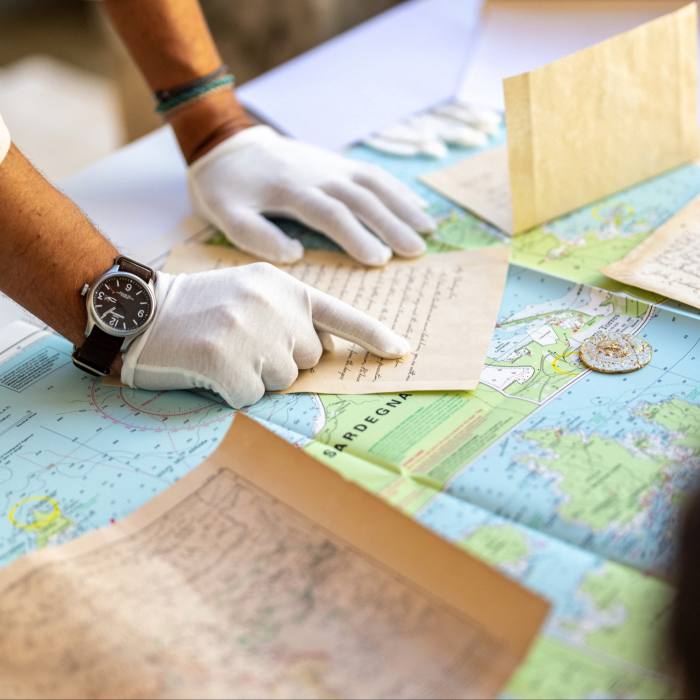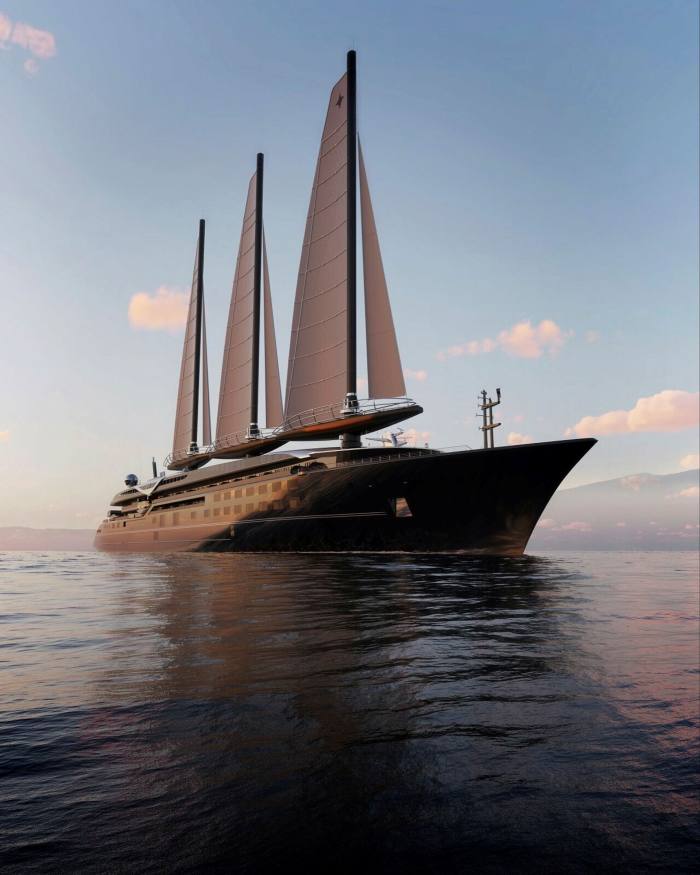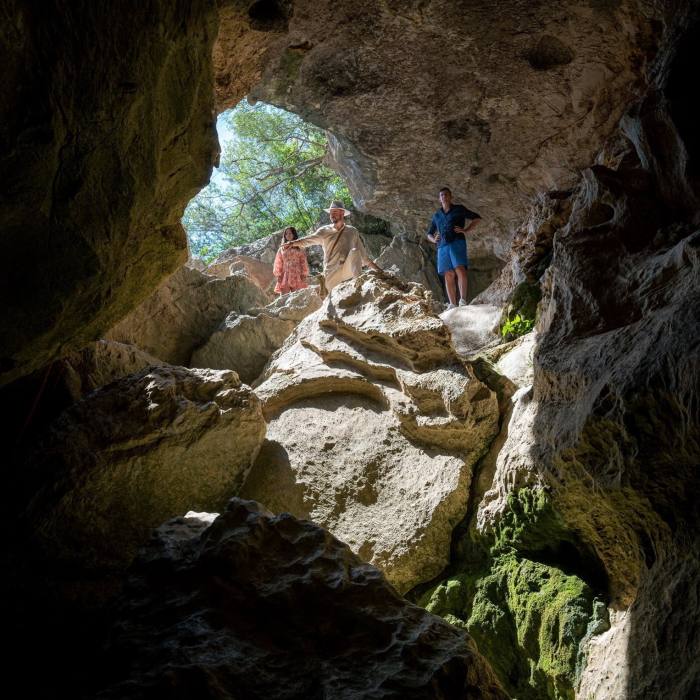[ad_1]
Augmented reality travel
When Esther Spengler walked alone out of a remote camp in Morocco’s Atlas Mountains, she was in search of something more than a travel experience. For the next three days, she would hike across rocky hills and to the edge of the desert, sleeping each night under a tarpaulin, until she made it to a pre-agreed extraction point. “After having children, I kind of felt I’d lost myself and my zest for life, I guess,” she says. “But when I discovered this, it was finally like, after literally years, I felt excited about something.”
The mother of two from Austin, Texas, had stumbled across an online video for “Get Lost”, a service from the London- and New York-based travel company Black Tomato promising “the ultimate experience for helping people to disconnect, engage in the moment and push themselves”.
Its proposition sounds more like the set-up for a reality TV show than a holiday. Guests sign up without knowing where they are going, undergo a brief crash-course in survival, are dropped into the wilderness, and then must make their way out, perhaps with a few strategically placed caches of water and firewood en route. Rather than a film crew, they are trailed, discreetly, by an operations team — in Spengler’s case, an ex-British marine using a GPS tracker to remain about a kilometre away.
Though undertaken by only a small number of clients, Get Lost is an example of an emerging trend in travel. For the past decade, the industry has excitedly promoted a switch from conventional luxury — where the worth of your holiday is denoted by gold taps and marble bathrooms — towards “experiential travel”, where the value is in memorable experiences, be they activities or cultural interactions. Now some high-end operators are pushing further to make the experiences even more immersive, sometimes adding a layer of challenge, or a game, sometimes even involving actors in a process of “storification”.


Luxury Treasure Hunts, for example, last year began offering adventures along the coast of Sardinia, in which guests find clues, explore caves and decipher parchment letters in the search for lost gold coins. Set up by Charlie Moretti, a former film producer, it uses actors, screenwriters, set designers and prop-makers to create realistic one- to three-day quests for guests travelling by yacht.
As well as its Get Lost experience, Black Tomato is leaning into the augmented reality concept. It already offers “Take me on a Story” family trips, immersive itineraries that draw on classic tales from Alice in Wonderland to Treasure Island, promising guests the chance to “step into the pages” of the books. This spring it will launch “The Assignment: Europe”, the result of a collaboration with Eon, the production company behind the James Bond movies, offering guests a series of experiences inspired by the films and created with the help of their location managers. Think water-skiing along Lake Como, stunt-driving classes and casino visits.
Some will be critical, arguing that it’s a move away from travel as a means of connecting with a destination. But for others it’s a way of elevating the experience.
“I think what’s unique about this, as opposed to going on a vacation or just a hike, is that it really pushes you to the edge of yourself,” says Spengler. “And then it’s like, when you strip away all the technology and financial worries and just the loud noise of our everyday lives, it just leaves you with this beautiful sense of clarity on life — that’s when you begin to discover all sorts of things about yourself.” She is now planning to use the skills acquired on the trip to arrange her own “Get Lost” style adventures. “And when I got home I actually joined the army.”
Five-star hotels take to the water

The cruise sector may have lost billions and racked up vast debts during the pandemic — only to find itself now struggling with rising fuel prices — yet demand has remained surprisingly resilient. Now, a raft of new players is lining up to enter the market at the very top end and, rather than coming from the world of shipping, these are hoteliers taking to the water.
First to cast off was Ritz-Carlton, part of the Marriott group, whose 190-metre yacht Evrima had its naming ceremony in Lisbon in November. With 149 cabins (and 246 crew), it will be followed by two more ships to create the “Ritz-Carlton Yacht Collection”, designed to replicate the hotel experience at sea and draw on an existing client base who may not have cruised before.
Chris Gabaldon, Marriott’s senior vice-president for luxury brands, says the group wants “to give our guests the opportunity to experience the Ritz-Carlton in a new way”. Rather than the buffets popular on big cruise ships, the Evrima offers five restaurants, including one created by Sven Elverfeld, chef at the three Michelin-starred restaurant at the Ritz-Carlton in Wolfsburg, Germany.
Not to be outdone, Four Seasons is currently building its own ship in Trieste, Italy, with plans for two more. At 207 metres, it will have 95 suites; the company says it is spending the equivalent of $4.2mn per cabin, with a top-of-the-range option, the Funnel Suite, having four levels and a private spa and pool. Reservations are due to open this year for voyages starting in 2025.
Both companies are at pains to talk about their “yachts” rather than cruise ships, but perhaps the Aman group has the best claim of genuinely blurring the line between cruise ships and private superyachts. Its new vessel — codenamed “project Sama” and also due for launch in 2025 — is 183 metres but with only 50 cabins.
Trumping them all, however, is Orient Express, the venerable railway brand now controlled by French hospitality giant Accor. The first Orient Express hotels are due to open in Rome and Venice next year, along with a new luxury train in Italy, and a restored historic one in 2025. Joining those the following year will be what the brand claims is the world’s largest sailing ship, the 220-metre Orient Express Silenseas. In fact, though the three rigid sails and 100-metre-high masts will be able to propel the ship in the right conditions, it is a hybrid rather than a pure sailing vessel, with engines powered by liquefied natural gas. “Inspired by the golden age of the French Riviera”, it will have just 54 suites.
Long weekends
Sunday used to be many hotels’ quietest night, as weekenders returned home to prepare for the Monday commute. That is changing as more people work from home on Mondays and Fridays, making it easier to take long weekends. The Newt hotel in Somerset, for example, reports “booming” demand for Sundays — “there’s a celebratory atmosphere in the hotel that night as it’s like a bonus,” said a spokesperson. The Pig chain of English hotels says weekend stays including a Sunday night are up 14 per cent on 2019 levels.
Tour operator Original Travel mothballed its weekend trip portfolio in 2021 after receiving “close to zero inquiries” and, according to co-founder Tom Barber, “for a time it looked like they would be a permanent casualty of the pandemic”. Now, however, that trend seems to be reversing, and the company has relaunched its “big short break” collection, also pointing to the four-day week campaign, a movement which has prompted some 100 UK companies to move to shorter working weeks with no loss of earnings for staff.
Next-level camping


Whatever the latest indulgences offered by the world’s smartest hotels, at the cutting edge of the luxury travel market, the buzz is all about camping. Advances in tent design and heating systems, combined with growing demand for wilderness immersion, has led to extravagant camps popping up in ever-more remote settings.
Earlier this month, Cookson Adventures hosted a “floating camp” powered by solar panels and biofuel cells on the frozen Fjallsárlón, a glacial lagoon in southern Iceland. Four heated guest “tents” (which sat on the solid ice but are also capable of floating) were set around a wooden sauna and hot tub, at the foot of Vatnajökull, Iceland’s largest icecap. A hole was sawn into the ice so guests could leap from the sauna into the icy water below.
In March, the same company will launch another camp deep in the interior of Svalbard. Despite being a four-hour snowmobile trip from Longyearbyen, and sitting on a glacier, it will offer heated showers and toilets, a chef, library — and rates starting at £230,000 per week for a group of six.
Last month, though, saw the launch of an even more remote and eye-catching camp. White Desert’s Echo Camp in Antarctica features six futuristic “sky pods” built of fibreglass panels and with floor-to-ceiling windows. Activities include hiking, skiing, fat-biking and visiting penguin colonies. Prices start at $65,000 per person for five days, including flights from Cape Town. Photographs taken from the International Space Station by Colonel Terry Virts, a former guest at one of White Desert’s other camps, are displayed in each pod. Describing the landscape around Echo Camp, Virts says, “the mountains are the most beautiful I have seen across Earth, Venus and Mars.”

At a more down-to-earth level, Under Canvas has ridden the rise in interest in camping to go from opening its first camp in West Yellowstone a decade ago, to running 10 locations across the US. Next month it launches a new brand, Ulum, promising more upmarket tents (from $549 per night), hot and cold dipping pools and complimentary activities including yoga, star-gazing and hiking, as well as live acoustic music. The so-called “suite tents” have king-size beds, lounge areas, en-suite bathrooms, evaporative cooling fans and wood stoves, Pendleton blankets, plus 70 sq ft decks. The first Ulum will be on a 200-acre site close to the Looking Glass Arch in Moab, Utah.
Corporate bonding
After a near-total pause during the pandemic, business travel is returning, but with one big shift in emphasis. Alongside the traditional purpose of meeting potential clients and collaborators, companies are hosting trips so that their own staff, who are increasingly working remotely, can get together.
A survey conducted by American Express in the UK last year found that 73 per cent of companies now saw connecting remote teams as a key reason for business travel. Gleneagles in Scotland, for example, says it is “hugely benefiting” from the trend, with visiting groups typically spending a couple of ours in meetings before heading outside. “Companies want to mix up the formality of a meeting with something their employees haven’t tried before – fly fishing or some off-road driving,” says Conor O’Leary, Gleneagles’ managing director.
Some lucky employees are even meeting up in ski resorts. Kaluma Ski, a specialist operator based in St Anton and Courchevel, says its corporate bookings for this winter have risen beyond pre-pandemic levels.
Set-jetting
The term “set-jetting” — meaning travelling to see places featured in movies or television — was coined almost 20 years ago, in response to the boost to New Zealand tourism from The Lord of the Rings series. However, it has grown from a niche pursuit to become a major driver for the travel industry: Expedia says data from global surveys it conducted last autumn shows that two-thirds of travellers have considered trips to destinations seen on screen and 39 per cent have actually made bookings (only 2 per cent behind the most important source of inspiration: recommendations from family and friends).
The global reach of streaming services, along with their increasing popularity during the pandemic, has supercharged the trend, meaning that a worldwide audience can become aware of a particular destination on the same day.
The biggest beneficiary for 2023 is likely to be Sicily, the setting for the second season of The White Lotus. The San Domenico Palace, the Four Seasons resort in Taormina where it was filmed, won’t divulge booking figures, but Lorenzo Maraviglia, the general manager, says the show has had “an incredible impact”. When tour operator Abercrombie & Kent posted on social media that it was able to arrange stays at Palazzo Cardinale, the villa to which the two wives in the show escape for a night (in Noto in the show, though the house is actually outside Palermo), the company saw web traffic spike 2,000 per cent week-on-week. The Thinking Traveller says Sicily is currently its fastest-booking destination, with the White Lotus driving demand across the island rather than just in Taormina.
Another “set-jet” hotspot this year will be the Norwegian fjords, where members of the Roy family will travel to meet Waystar Royco’s potential new owner in the forthcoming season of Succession (due out in spring). Filming locations included the cable car at Romsdalen and the Juvet Landscape Hotel (which already featured in the sci-fi film Ex Machina). Meanwhile in the US, the success of Yellowstone and its spin-offs continues to drive soaring demand for dude ranches and other trips to the western states.
Hitchsailing: how I swapped flying for thumbing a lift on the waves

My first time catching and gutting a fish is all the more memorable for the eight-foot waves that send the boat swaying like a pendulum, writes Imogen Lepere.
The fish itself — some sort of grouper — has no intention of going quietly. As a born and bred Londoner, I’m not used to giving my food the dignity of eye contact before eating it, and am finding the experience extremely disconcerting.
“Start at the tail and slice all the way to its head,” directs captain Joel Uve, a tattoo artist who looks every inch the millennial pirate with a world map inked on his chest and the sort of wire-rimmed spectacles one normally sees hovering above a MacBook. I’m glad the boat is rocking too much for him to notice how much my hands are shaking as I grab a gooey fistful of fish guts.
We’re sailing from Havana, Cuba, to Merida in Mexico, a journey of 422 nautical miles aboard a monohull boat named after the Cuban sea goddess, Yemanjá. At just 32ft and with a single bed between our crew of three (including artist Carlos Pérez, a longtime friend of Uve), it’s a far cry from my only other sailing experience — a luxurious phinisi overseen by 10 adept Indonesian sailors plus a private chef. It will take us six nights to complete a journey that lasts just 90 minutes by air.
Hitchsailing — negotiating lifts with boats already travelling to a destination — is a growing trend among travellers seeking a low-carbon alternative to flying. While some go straight to a marina to find a ride, most make initial contact through social media. The Facebook page Hitchhikers and Crew Connection currently has 67,000 members, Atlantic Ocean Crew 14,000 and Caribbean Sailing Crew 9,200. Unlike professionals and experienced sailors who have always exchanged labour for passage, this new wave of eco-minded travellers are frequently novices.
One of the movement’s leading voices is Suzanne van der Veeken, author of Ocean Nomad — The Complete Atlantic Sailing Crew Guide: How to Catch a Ride to Contribute to a Healthier Ocean and founder of Ocean Nomads, an online network that aims to connect hitchsailors with captains seeking crew. Van der Veeken believes that aside from the carbon savings of travelling by sail, a personal sense of responsibility also often results from ocean life. “If you actually see a trawler vessel scraping the seabed in Thailand or a remote Pacific beach covered in plastic, it gets into your heart in a way that hearing about these things second-hand just can’t, ” she says.
In comparison to other forms of transport, sailing can be arduous and at times dangerous; an experienced captain is vital. Farmer Michael Schmidt, from Umbria, recalls the time he was hitching through Cape Verde when the boat’s foremast snapped, leaving the crew stranded on the arid island of Boa Vista for three weeks. Eventually they managed to cobble together a makeshift mast from driftwood that enabled them to reach a nearby island with a boat yard.

Has it put him off? Far from it. “It’s this kind of challenge that creates the accelerated personal growth I think people are searching for when they travel,” he says. “Depending on how a boat is maintained and how often the motor is used, sailing can also cause pollution but far less so than flying or ferries. Knowing you can explore the world without actively causing harm is so liberating.”
Back on the Yemanjá, I am gradually consumed by life at sea. Hours flow gently into one another. We listen to cumbia music and smoke fat Cuban cigars. Pérez sketches and tells me tales about their voyage from the Canary Islands to Cuba, a journey of 5,500 nautical miles conducted on just 10 litres of petrol. Occasionally the blue surface is broken by the silken back of a dolphin or a stingray leaping into the air as some unseen drama unfolds beneath us.
Throughout the night, we take it in turns to do four-hour watches, scanning the horizon for other vessels and ensuring the boat stays on course. With the rest of the crew in bed, the only lights are those of the stars and the phosphorescent plankton that burns in our wake like the tail of a comet.
Sleepily, I think back on what Uve said when I asked why he sails: “The wind, the waves, the passage of the sun and the pull of the moon — you’re so far away from everything humans have created and physically being moved by the power of nature. For me, it’s the purest form of travel and the closest I can get to real freedom.” And doesn’t being free of the guilt many of us now associate with flying take this sense of liberty one step further?
Find out about our latest stories first — follow @ftweekend on Twitter
[ad_2]
Source link







